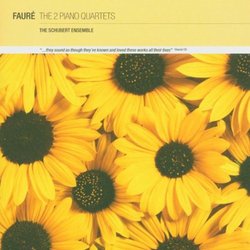| All Artists: Gabriel Faure, Schubert Ensemble of London, The Schubert Ensemble Title: Fauré: The 2 Piano Quartets Members Wishing: 0 Total Copies: 0 Label: Asv Living Era Release Date: 3/22/2005 Genre: Classical Styles: Chamber Music, Historical Periods, Classical (c.1770-1830), Modern, 20th, & 21st Century Number of Discs: 1 SwapaCD Credits: 1 UPC: 743625304022 |
Search - Gabriel Faure, Schubert Ensemble of London, The Schubert Ensemble :: Fauré: The 2 Piano Quartets
 | Gabriel Faure, Schubert Ensemble of London, The Schubert Ensemble Fauré: The 2 Piano Quartets Genre: Classical
|
Larger Image |
CD Details |
CD ReviewsFaure's 2 Piano Quartets Amy | 08/07/2007 (5 out of 5 stars) "Gabriel Faure was living and working in France during a period when music was changing drastically, making the transition from the romantic style of Brahms and Schumann, through the revolutionary harmonic changes of Wagner, to the early 20th century modernism of Schoenberg, Debussy and Stravinsky. While his music is characterized by a certain reserve of sentiment, it definitely shows the influences of the french school.
He was trained as an organist and choirmaster and later came under the influence of his teacher Camille Saint Saens, who was a virtuoso pianist. It follows that the majority of his works are written for voice, piano and organ. Faure often questioned the quality of his own works. It was not until his songs became popular in the salons of Paris that he gained much recognition for his music at all. He did however, have a certain amount of confidence in his capabilities in his chamber music. His interest in the chamber music form spanned his entire career from his first violin sonata, published in 1877, to his string quartet, published posthumously in 1925. His particularly beautiful music for strings and piano draws on both his beautiful sense of the song and a his concept of a particular melody's interaction with its accompaniment. His music is uncluttered without being sparse and creates a certain atmosphere of simplicity and poignancy which is very appealing. in his chamber works, the piano parts, seem to break the music into tiny pieces, like a musical kaliedoscope. Faure was not a virtuoso pianist himself, yet his piano parts are often extremely challenging. The unusual distribution of parts between the two hands and interesting finger substitutions are probably due to his training as an organist and the fact that he was ambidextrous.The first piano quartet was written fairly early on in his career over the period between 1876 and 1879. It clearly shows the influence of Brahms, he has a similarly good understanding of the differences in sound and character between the strings and the piano. He opens with a very romantic, orchestral main theme by the unison strings which is soon transformed into a beautiful melody. The melancholic Adagio, which is my favorite part of this song exhibits Faure's exquisite understanding of the emotional range of the cello. The strings answer the piano to develop the moving theme. The piano closes off the movement quietly. His concluding Allegro Molto opens with a racing piano part which is echoed in the strings. This is contrasted with a second, more singing theme. Faure's Piano Quartet in G Minor is musically structured very much the same as the C Minor Quartet. These performances of Fauré's piano quartets are chamber work masterpieces and should be in every collection." |

 Track Listings (8) - Disc #1
Track Listings (8) - Disc #1